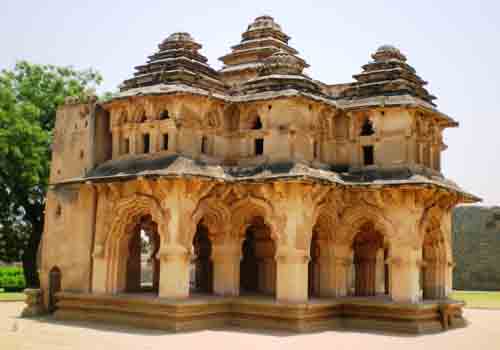Lotus Palace

Information on Lotus Palace (Hampi, Bellary, Karnataka) - History & Architecture
Lotus Mahal is located in zenana enclosure in the world heritage village of Hampi, in the district of Bellary, in the state of Karnataka, in South India. It is a beautiful palace for the queen. It is a well-planned residential structure that belongs to the later Vijayanagara period. Hampi is the present ruined capital city of the historic Vijayanagara Empire. In the Royal Centre of Vijayanagara, it is the best well-preserved courtly structure. It is one of the popular structures that are known for its historical and architectural significance in Hampi. It largely attracts domestic and foreign tourists.
Lotus Palace Architecture
Lotus Mahal is entirely constructed in stone. It is to be remembered that it is clear deviation from residential structure and palace conventional Vijayanagara period constructional methgods and patterns that largely used hard wooden structures on platforms made of massive stone. In its vaulted ceilings and arched gateways, this particular structure reflects Islamic influence. It is a pleasure pavilion. It served as a meeting place for the Emperor and his queen plus his closest advisors. In 1799, the initial map of the site prepared, this palace is referred as a "Council Chamber". It is to be highly noted that in the northeast corner of the Royal Centre, it perfectly stands near the centre of a high walled compound as a private enclosure. This particular enclosure also comprises various water features, and the remains of two palaces and a vaulted structure of uncertain private purpose. On the other hand, square and octagonal watchtowers are built with balconies into the compound walls. Within the enclosure, there are well-built elephant stables that can be reached through a small doorway.
According to the historians, with equal measurement projections on four sides, the palace is symmetrically laid out with a lot of perfection. This structure has two storeys which are both having deeply indented margins but with lobes not entirely separate from each other arched openings within the given multiple planes that is surrounded by elaborate plaster designs. In order to protect the walls from the rain and sun, curved eaves run continuously around the residential structure. Eight pyramidal towers rightly rise over the corner and central bays of the building. On the other hand, a ninth tower is much higher than other towers that stand above the central bay. In one corner, the staircase tower is a later addition.
Lotus Palace History
Lotus Mahal is an important structure in the historic Vijayanagara Empire that was successfully founded by the Sangama brothers named Bukka Raya and Harihara. It is situated on the south side of the River Krishna which is more secure and defensible location in the entire region of their kingdom. This kingdom in a successful manner flourished between the 14th century and 16th century. It faced lot of conflicts from Deccan sultanates. This empire's armies largely suffered catastrophic and massive defeat and capital as taken by the alliance of the Deccan sultanates in 1565. Over a period of several months, the victorious armies of the sultanate then went ahead destroy, raze and depopulate the capital city and its good number of Hindu icons and temples. Most of the buildings and large structures were built as per the Hindu tradition and culture followed in south India. Later, the Vijayanagara structure had Islamic influence under the rule of Deccan sultanate.
Lotus Palace Tourism Importance
Lotus Mahal and other structures in Hampi are mostly visited by domestic and foreign tourists because of its unique historical and architectural significance. The ruined remains of this capital city of Vijayanagara Empire speak a volume of the bygone era. It is located in the silent village named Hampi.
- Bangalore Monuments
- Bagalkot Monuments
- Belgaum Monuments
- Bellary Monuments
- Bidar Monuments
- Bijapur Monuments
- Chitradurga Monuments
- Coorg Monuments
- Dakshina Kannada Monuments
- Gadag Monuments
- Gulbarga Monuments
- Hassan Monuments
- Mysore Monuments
- Raichur Monuments
- Uttara Kannada Monuments
- Yadgir Monuments
- Andaman Nicobar Monuments
- Andhra Pradesh Monuments
- Assam Monuments
- Bihar Monuments
- Chhattisgarh Monuments
- New Delhi Monuments
- Goa Monuments
- Gujarat Monuments
- Haryana Monuments
- Himachal Pradesh Monuments
- Jammu and Kashmir Monuments
- Karnataka Monuments
- Kerala Monuments
- Madhya Pradesh Monuments
- Maharashtra Monuments
- Odisha Monuments
- Punjab Monuments
- Rajasthan Monuments
- Tamil Nadu Monuments
- Telangana Monuments
- Uttar Pradesh Monuments
- West Bengal Monuments